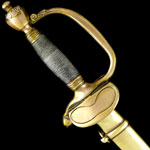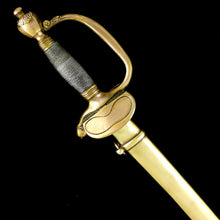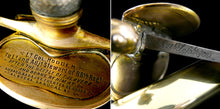Fighting Sword Carried by the Adjutant of Connaught Rangers in The Peninsula War
Adding product to your cart
Measurements: Overall Length: 103cm (44.5ins)
A George III 1796 pattern infantry officer's sword with gilt hilt and wire-bound grip, the German steel blade by John Justus Runkel of Solingen, and the guard bearing a Victorian period inscription: ‘Lt. Col. Hodder / To Lt. and Adjt. Stewart of 88th Regt / After the Battle of Talavera / And borne by him at Busaco, Badajoz, Fuentes de Onoro / Albuera, Sabucal &c.’, complete with continental style brass scabbard.
The present sword saw extensive usage in the Peninsula War in the hands of two junior officers of 1 Connaught Rangers – a battalion regarded as one of the most fearsome in Wellington’s Peninsula army - being gifted by Lieutenant William Hodder of Hoddesrsfield (1791-1859), while on active service to Lieutenant John Stewart in 1809. Stewart became Adjutant of 1/88th Foot – aka ‘The Devil’s Own’ - in June 1810, and was wounded and mentioned in despatches by Wellington for services at Fuentes d’Onoro.
Read more
Lieutenant & Adjutant John Stewart was commissioned Ensign in 1805/6. He embarked with the 88th Regiment on General Whitelocke's ill-fated expedition to South America in November 1806 and became lieutenant on 11 June 1807. On 5 July he was present in the British attack on Buenos Airies and was wounded in the street fighting with the local inhabitants, militia and Spanish regulars.
He landed in the Peninsula with 1/88th in March 1809 advanced with Sir Arthur Wellesley’s Allied army into Spain. Richard Cannon’s Historical Record of the 88th Foot indicates he was acting as Adjutant by July when a misunderstanding between the Allies compelled Wellesley to send the 3rd Division and some cavalry to cover the retreat of Spanish forces under General Cuesta to the chosen Talavera battle-position.
Cannon’s anecdote places Adjutant Stewart close to the near capture of Sir Arthur Wellesley by a French skirmishers, and relates the division was heavily outnumbered as it retreated through woods. The soldiers were forbidden to open fire during the retreat unless they ‘could cover their man’. Stewart gave permission for a Ranger to attempt a difficult shot at a French officer directing the fire of enemy skirmishers. The Ranger found his mark and the skirmishers melted away. Stewart was duly present on 27-28 July 1809 at the Battle of Talavera where the Allies held off three determined attacks by Marshal Victor’s corps. In the wake of Talavera Wellesley was ennobled as Viscount Wellington.
In 1810 a newly enlarged French army under Marshal André Masséna's invaded Portugal. On 28 June Stewart formally succeeded Duncan Robertson as Adjutant of the 1st Battalion, and was thus serving in this capacity at the Battle of Busaco where the Allies slowed the French invaders and where and 1/88th, appearing from a reverse slope position, impressed Wellington with a decisive bayonet charge.
From October 1810 Marshal Masséna's Army of Portugal was tied down in the stand-off against Wellington’s Allied forces, safely entrenched in and behind the Lines of Torres Vedras. In early 1811 Masséna's baffled and starving army withdrew towards Spain. Accordingly Stewart participated in Wellington’s pursuit being present in the actions at Redinha, Casa Novo and Foz d’Arronce between 12 and 15 March, and at Sabugal on 3 April 1811, that were invariably frustrated by the generalship of Marshal Ney.
In early May Masséna determined to relieve the Spanish-Portuguese frontier town of Almeida. Wellington prepared to check his advance at Fuentes d’Onoro while continuing to blockade Almeida and keep communications open across the Coa at Sabugal. Fuentes changed hands during the first two days of the battle, and after eight hours’ fighting on the third, Wellington counterattacked with units led by 1/88th Connaught Rangers. Again under Wellington’s gaze and in sight of both armies the battalion advanced in column of sections in double quick time. A battery of French eight-pounder cannon poured grapeshot into the ranks but failed to halt the advance. The French 9th Light Infantry supported by several hundred grenadiers were swept before them, as exhausted British troops all along the line rose up and gave chase. During the action Stewart was wounded and together with his commanding officer, Colonel Wallace, was afterwards mentioned by Wellington in his despatch of 8 May for distinguished service at Fuentes d’Onoro. By way of a more tangible reward Stewart was given the Brevet rank of Major in the army.
The French abandoned Almeida at night a couple of days later but retained the twin fortresses of Ciudad Rodrigo and Badajoz, the 'Keys' guarding the roads through the mountain passes into Portugal.
Meanwhile on Napoleon’s orders Marshal Soult had led a French expedition south in a bid to ease Masséna's plight and was able to capture the strategically important border fortress at Badajoz. Wellington detached Beresford to besiege Badajoz but in mid May he broke off to fight Soult's 'Army of the South' to a mutual bloody standstill at the Battle of Albuera. The sword’s Victorian inscription puts Stewart at Albuera it should be noted that the 88th were not present as a whole.
On 14 May 1811, the 3rd and 7th Divisions left the northern front and set out for Badajoz, being overtaken by Wellington, who was to take personal charge of the siege, en route. Stewart is recorded as being present at the second siege maintained between 18 May and 10 June, serving as before with his regiment in Mackinnon’s brigade. Stewart was promoted captain in the 88th on 5 September 1811 was present at the defensive action against French cavalry at El Bodon on the 25th, before going into winter quarters at Aldea da Ponte. In 1812 offensive operations were resumed earlier than was usual when an opportunity to assault Ciudad Rodrigo occurred on receipt of news of that French forces had been diverted away. Accordingly Stewart was present on 19 January with the 88th when they stormed the the Great Breach and the fortress town surrendered after considerable slaughter.
Captain John Stewart was still serving with the 88th in 1814 when the 1st Battalion was sent to Upper Canada to defend the frontier against American invasion during the War of 1812. After Napoleon’s escape from Elba, 1/88th and presumably Stewart (who appears in the 1815 Army List), were recalled to Europe but arrived too late for Waterloo and so spent 1815 as occupation troops in France.
The donor of the present sword, Lieutenant William Hodder, or Lt-Col William Henry Moore-Hodder, D.L., J.P., as he became, was the scion of an old Irish Ascendancy family; his mother, Harriet nee Clements, being a niece of the 1st Earl of Leitrim. His father was William Henry Moore (1769-1834) who took the additional name of Hodder on inheriting the Hoddersfield estate in County Cork from a maternal uncle in 1787. Hodder junior was born at Liverton, Devon, and commissioned Ensign in the 88th Foot (Connaught Rangers) on 17 September 1807 at the age of sixteen. In February 1809 he embarked with the newly raised 2nd Battalion at Cork as part of a large reinforcement (drawn in large part from the Irish militia) for Wellington’s army in the Peninsula.
On arrival at Lisbon, Hodder was posted to the 1st Battalion, while the 2nd Battalion under Colonel Alexander Wallace proceeded to Gibraltar. Hodder, who was promoted Lieutenant on 8 July, was accordingly present with 1/88th at the Battle of Talavera on 27-28 July 1809 where the Connaught Rangers suffered 136 casualties over the two days. In February 1810, 1/88th, now under Wallace’s command, joined the Picton’s Third Division. Hodder was next present at the Battle of Busaco on 27 September 1810, where 1/88th were instrumental in repulsing the attack of Reynier’s II Corps with a bayonet charge that caused Wellington’s remark: "Wallace, I have never witnessed a more gallant charge."
During the tactical withdrawal of Massna’s 49,000 strong army in 1811, Hodder was present in the attacks on Ney’s rear-guard at Redinha on 12 March and at the village of Casa Novo two days later where the Light Division over reached itself and had to be rescued by Picton’s. On the 15th Hodder was with the force that surprised a French covering division ‘in the act of cooking’ at Foz d’ Arronce. In his memoir, ‘Adventures With Connaught Rangers’ William Grattan recalled the appalling cruelty of the French to their abandoned draught animals and the savagery of the Portuguese peasantry on any Frenchman unlucky enough to fall into their hands. On 3 April having overcome supply difficulties, Wellington caught up with Massena at Sabugal whence Hodder took part in the attack across the River Coa, which although successful had to be halted due to torrential rain.
A month later Hodder was present at Wellington’s interception of Masséna’s army at Fuentes d’Onoro as the latter tried to reach the frontier town of Almeida. Here after two days’ fighting, Hodder participated in the Rangers‘ celebrated advance into the village occupied by General Drouet's corps. The ensuing visceral engagement further endorsed the street fighting prowess of the 88th, and turned tide of the battle. A party of hundred and fifty French grenadiers wearing bearskins were trapped in a cul-de-sac, and, despite breaking into houses and trying to escape up the chimneys, were killed by the Rangers along with the rest.
Hodder’s final action was at El Bodon on 25 September 1811. Here the Picton’s Division were surprised by a strong French cavalry force some 2500 strong under General Montbrun. The British recovered quickly and staged a fighting withdrawal holding off the assaults for more than ten kilometres. French losses have been put at about 200, while Picton's troops suffered about 150 casualties.
Hodder left the Peninsula in October 1811 and retired from the regular service in 1813. He subsequently inherited the Hoddersfield estate and held the lieutenant-colonelcy of North Cork Militia (N.C.M.) of which his father was Colonel and had long served, having succeeded Lord Kingsale as second in command immediately after the Irish Rebellion of 1798. In 1847 Hodder had survived long enough to successfully apply the Military General Service Medal, 1793-1814, with clasps for Talavera, Busaco and Fuentes d’Onoro.
Thirty-nine years after the post-Waterloo disembodiment of the N.C.M., ‘Wm. H. M. Hodder, late 88th Foot’ was actively re-employed as Colonel when the militia corps was numbered 116th in the line and re-equipped as Rifles for home service during the Crimean War and Indian Mutiny. While on garrison duty in Scotland ‘the North Cork Rifles experienced a sad loss by the death of their gallant old chief, Colonel Hodder. Whilst dismounting from the horse he had been riding at the head of the regiment that morning, he fell backwards on his head in the barrack-yard, never recovered consciousness, and died on the 20th of November, 1859. The corpse was followed to the railway station at Ayr by the whole regiment, from whence it was conveyed to Ireland for interment at Carrigaline, County Cork. He married twice, firstly to Charlotte Colthurst, of Ardrum, co. Cork, sister of Sir Nicholas Conway Colthurst, Bart. She died in 1832 and he married secondly in 1839 Lucy Elizabeth Mary, daughter of Colonel Need of Mansfield Woodhouse, Nottinghamshire, by whom he had issue.
References:
For Hodder:
Abandoned Ireland (http://www.abandonedireland.com/Hoddersfield_House.html)
Army Lists: 1808, 1809, 1810, 1811
Burke’s Landed Gentry of Ireland, 1912
Challis, L.S., ‘Peninsula Roll Call’ (accessed 10.1.2015)
Grattan, Wm., (1848) Adventures of The Connaught Rangers: from 1808 to 1814, Oman edition 1902
Mercer, Maj. J.D (1888) ‘The Record of the North Cork Regiment of Militia, 1793-1880’, Dublin
For Stewart:
Army Lists: 1806, 1808, 1809, 1810, 1811, 1815
Cannon’s Historical Record of the Eighty-Eight Regiment of Foot, or, Connaught Rangers
Challis, L.S., ‘Peninsula Roll Call’ (accessed 10.1.2015)
Grattan, Wm., (1848) Adventures of The Connaught Rangers: from 1808 to 1814, Oman edition 1902
Hall, J.A. (1998) Oman, Sir Charles, A History of the Peninsula War, Vol. VIII, The Biographical Dictionary of British Officers Killed and Wounded, 1808-1814, London
Jourdain, Lt-Col. H.F.N. (1924) The Connaught Rangers, Vol. I, R.U.S.I., London








